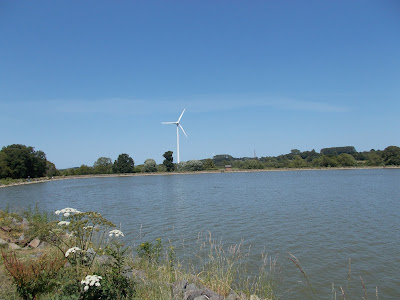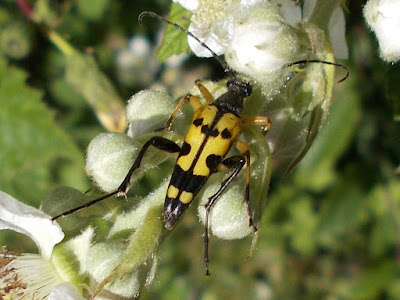I was determined not to visit Stefen Hill Pocket Park today but, with the weather looking questionable I didn't want to venture too far. For or a change I took the A351 to Badby and then turned west on to a little-used road leading to the hamlet of Upper Catesby.
My objective was the curiously-named Konigssee Farm. The Konigsee is a lake in Germany, situated in Bavaria. I was surprised that the lake, Germany's third largest, was named after this farm (although I suppose the farm could have been named after the lake).
The visit got off to a promising start for, on a leaf beside the footpath leading to the farm was a moth, a Large Fruit-tree Tortrix, Archips podana.
 |
The Large Fruit Tree Tortrix is abundant and widespread.
Near Konigssee Farm, Badby.
|
This is a very common moth of course but I felt that it foretold of good things to come. I was wrong! Within a minute the heavens opened and it chucked it down for two minutes. A nearby ash tree offered the only, but barely adequate, shelter until I was able to set off again.
Oddly enough the next insect to come to my attention was another moth, this time a footman. It was, perhaps predictably, a Common Footman, Eilema lurideola. Like the tortrix, it sat nicely and smiled at the camera.
It was sheltering on some plastic mesh in the lee of a barn. The barn was one of a collection of sheds, etc. forming a smallholding with a couple of fields, a handful of horses and some Shetland-type ponies. It was worrying to note that piles of horse/pony droppings were piles up in various spots around the fields and showed no signs of decomposition. At least one huge pile looked to have been there for several years and was largely covered in nettles. Where were the dung beetles and other agents of decomposition? It is tempting to suspect that Ivermectin has been used liberally in the area; its effect upon dung beetles and other insects can be devastating.
The two fields contained a surprising amount of Self-heal, Prunella vulgaris. With the horses constantly grazing I would have expected the flowers to have been nibbled off. Are the distasteful?
Oddly enough the next insect to come to my attention was another moth, this time a footman. It was, perhaps predictably, a Common Footman, Eilema lurideola. Like the tortrix, it sat nicely and smiled at the camera.
 |
Sometimes venturing into houses, the Common Footman is quite a
familiar moth. Near Konigssee Farm, Badby, Northants
|
It was sheltering on some plastic mesh in the lee of a barn. The barn was one of a collection of sheds, etc. forming a smallholding with a couple of fields, a handful of horses and some Shetland-type ponies. It was worrying to note that piles of horse/pony droppings were piles up in various spots around the fields and showed no signs of decomposition. At least one huge pile looked to have been there for several years and was largely covered in nettles. Where were the dung beetles and other agents of decomposition? It is tempting to suspect that Ivermectin has been used liberally in the area; its effect upon dung beetles and other insects can be devastating.
The two fields contained a surprising amount of Self-heal, Prunella vulgaris. With the horses constantly grazing I would have expected the flowers to have been nibbled off. Are the distasteful?
 |
Self-heal is a familiar plant even in urban lawns. Near Konigssee Farm,
Badby, Northamptonshire.
|
This pretty plant is a member of the mint family and I anticipated to see plenty of bees calling in for nectar, but I saw none. Perhaps the rain had discouraged them. Its common name is a reminder that Self-heal was once highly esteemed in herbal medicine, often taken as a tea for the relief of sore throats and other ailments.
Very little Self-heal grows on nearby Foxhill Farm; perhaps the conditions there - slightly on the acid side - do not really suit it.
So, no dung flies noted but I was pleased with the abundance of ladybirds. They were mostly - and predictably - 7-Spot and were in all stages.
 |
| Its pretty flowers are beloved of bees. |
Very little Self-heal grows on nearby Foxhill Farm; perhaps the conditions there - slightly on the acid side - do not really suit it.
So, no dung flies noted but I was pleased with the abundance of ladybirds. They were mostly - and predictably - 7-Spot and were in all stages.
 |
Coccinella 7-punctata, the 7-spot Ladybird, in familiar colours. Near
Konigssee Farm, Badby, Northants.
|
Obviously those which most readily caught the eye were the fully developed imago forms but many were teneral, i.e. only just emerged from their pupae, and had not yet fully developed their bright red coloration.
 |
This specimen needs another hour or two for full coloration to
develop. Near Konigssee Farm
|
I was spending so much time on these two fields that I was clearly not going to reach Konigssee Farm. A surprisingly large bag of insects was accumulating but I was also keeping an eye open for unusual plants. In this latter quest I was unsuccessful, with only fruiting Lords and Ladies, Arum maculatum, meriting a photograph. (Unless one counts Spear Thistle, Cirsium vulgare, mined by the moth Coleophora peribendaneri).
 |
Coleophora peribendanderi usually attacks Creeping Thistle but
here it is on Spear Thistle. Near Konigssee Farm, Badby
|
Rain was again threatening so I made my way back to the car, but resolving to pay the area another visit soon.
Lords and Ladies, aka Parson-in-the-Pulpit, Cuckoo Pint, etc. is one of only two British native members of the Araceae, a surprisingly low number considering that, with around 3800 species, this is one of the world's largest families of flowering plants.
Lords and Ladies, aka Parson-in-the-Pulpit, Cuckoo Pint, etc. is one of only two British native members of the Araceae, a surprisingly low number considering that, with around 3800 species, this is one of the world's largest families of flowering plants.
 |
| The berries are ripening on Lords and Ladies. Near Konigssee Farm. |
When in flower it is instantly recognisable and many of the old vernacular names refer to the phallus-like spadix. The 'pint' part of Cuckoo Pint should rhyme with mint, as it was originally short for 'pintle', a now-obsolete mane for the penis. I could bore readers' socks off with the masses of folk lore associated with the plant and could exacerbate the problem by quoting John Clare - but I will kindly refrain. I am not a cruel man at heart, (but obviously Boris Johnson and the editors of the Daily Mail, Daily Express and the Sun are fair game).
Here comes the rain!











































